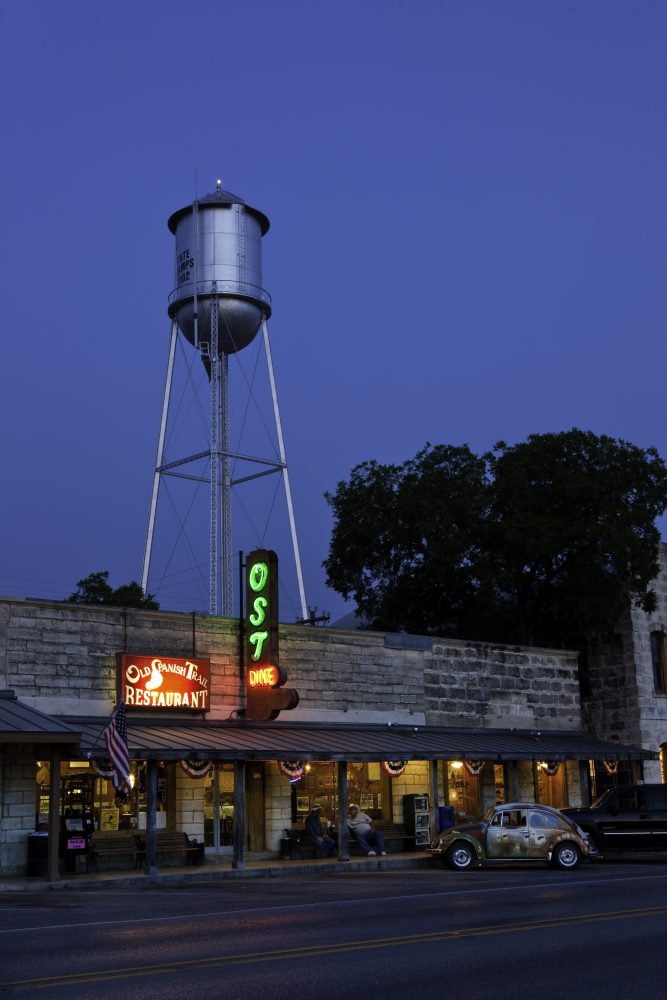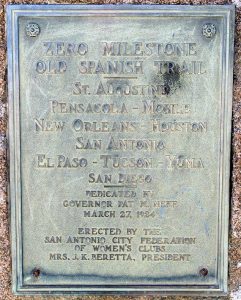
The Old Spanish Trail Restaurant in Bandera takes its name from the historic Old Spanish Trail roadway. Photo by J. Griffis Smith.
Interstate 10, US 90, and the Old Spanish Trail all traverse southern Texas from Orange to El Paso, their east-west paths converging on occasion. But there’s no question which route most inspires the imagination of travelers. The Old Spanish Trail—the least known of the three—evokes Texas’ storied past and inspires further adventure.
Answering that call to adventure, a San Antonio-based outfit called OST100 is commemorating the OST Centennial this year and throughout the 2020s. The decade-long celebration will conclude in 2029 with a motorcade from St. Augustine, Florida, to San Diego, California.
Back in 1915, delegates from Texas, Alabama, Arizona, New Mexico, and Arizona convened in Mobile, Alabama, to launch the Old Spanish Trail project. They formed the Old Spanish Trail Association, and after conventions in Houston and San Antonio in 1919, the heavy lifting of developing the idea into a national highway shifted to the Alamo City.

Dedicated in 1924, the Old Spanish Trail mile-zero marker still stands in San Antonio’s Military Plaza. Photo courtesy OST100.
The association established a headquarters office in the famed Gunter Hotel, and financier Harral B. Ayres—who had come to Texas from the Northeast for his health in 1917—was hired as managing director. Ayres nurtured a romantic narrative about the trail following in “the footsteps of the Padres and Conquistadores.” When the road was finally completed in 1929, King Alfonso XIII of Spain sent a representative to dedicate the OST.
About one-third of the trail—some 947 miles—passed through Texas. Vintage OST maps show nearly 50 Texas towns and cities. In the ensuing decades, much of the old road has disappeared or joined modern highways, but fragments can still be traced starting just west of the Sabine. The OST100 is documenting strands of the trail and engaging communities along the route with public events. (An upcoming Alpine event has been postponed.)
The OST follows US 90 and ALT US 90 through Beaumont, Houston, and Eagle Lake. At Columbus and Alleywood, the Alleywood Old Spanish Trail Historic District spotlights 1.4 miles of the old road. Then, Painted Churches country leads to Gonzales. The road continues west to San Antonio, where in 1924, Governor Pat Neff dedicated a “Mile Zero” marker at City Hall in Military Plaza.
“The original OSTA published annual travelogs with the exact distance from city center to city center,” explains Charlotte Kahl, director of the OST100. “If cities had not added their zero-mile markers, the travelog encouraged travelers to reset their odometers at zero at the depot, courthouse, or other site.”
A “tourist route” spinoff of the OST leads to Bandera, where the Old Spanish Trail Restaurant has served up comfort food dishes like chicken-fried steak since 1921. Off I-10, phantom patches of the old road are said to exist near Junction and Sonora. West of Ozona, an especially scenic stretch of the OST descends Lancaster Hill into the Pecos River Valley. Near El Paso, says Kahl, “We recently uncovered the OST route through San Elizario, based on the mileages in those mid-’20s travelogs. The trail diverged from the Bankhead Highway there in keeping with its ‘Mission to Mission, Fort to Fort’ theme.”








